
Triumph of the Church during treatment, gluing a split that almost separated this panel into two pieces. All photos in this article © José de la Fuente unless indicated otherwise
Dynamic brushwork, sumptuous tapestries. Both are on display for a little while longer in Spectacular Rubens: The Triumph of the Eucharist at the Getty Museum.
The show brings together four tapestries designed by Peter Paul Rubens in the early 17th century for the governor-general of the Netherlands, the Infanta Isabel Clara Eugenia, along with the exuberant preparatory oil sketches that helped the artist plan the tapestries’ final compositions. Iris readers may recall the effort it took to hang the four monumental tapestries in Los Angeles after their arrival from Spain (each is up to 25 feet wide and weighs 150 to 200 pounds). But did you know that a lengthy, careful effort was also required to safely transport the accompanying oil sketches (known as modelli) across the Atlantic—and the whole U.S. for that matter—so they could be shown at the Getty?
The conservation of Rubens’s oil sketches was undertaken over several years at the Prado Museum as part of a grant from the Getty Foundation through the Panel Paintings Initiative. The project included hands-on training for an international group of panel paintings conservators to ensure that there is a corps of experts in place to care for these complex artworks in the future, since the current experts will soon retire. To learn more about the painstaking conservation effort that lies, literally, behind the surface of Rubens’s gorgeous modelli, I spoke with one of the trainees who participated in the project—Jonathan Graindorge Lamour, a freelance conservator based in Paris.
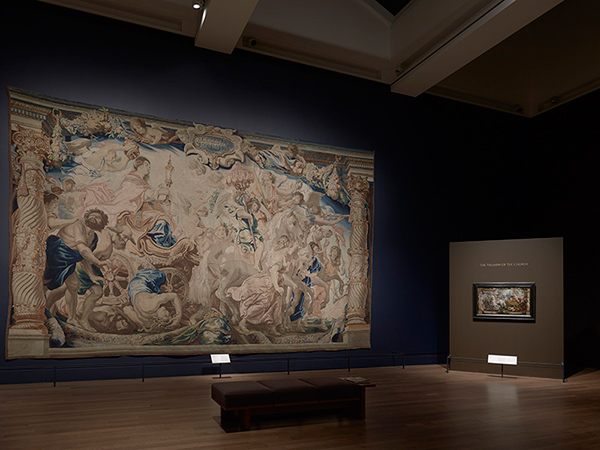
Installation view of Spectacular Rubens: The Triumph of the Eucharist at the J. Paul Getty Museum. Tapestry Copyright © PATRIMONIO NACIONAL; Photo © J. Paul Getty Trust
Katie Underwood: To paint the scene, so to speak, it would be helpful to know how Rubens came to develop these artworks. I understand you and the rest of the conservation team visited the original site for the tapestries during your training residency?
Jonathan Graindorge Lamour: It began when the Flemish master received a commission of a series of tapestries from the Infanta Isabel Clara Eugenia in the early 1620s. This large program, called Triumph of the Eucharist, was destined for the church of the Monasterio de las Descalzas Reales in Madrid. Trainees and experts had the opportunity to visit this place, and we tried to figure out how this large iconographic program designed by Rubens was displayed on the walls. Uncertainties remain about the precise location of each tapestry. Indeed, important modifications to the church interior occurred after the 17th century, like the raising of the floor or the removal of altarpieces. But nevertheless, it is still possible to feel and imagine the exaltation and faith that these tapestries must have solicited when displayed in this space.
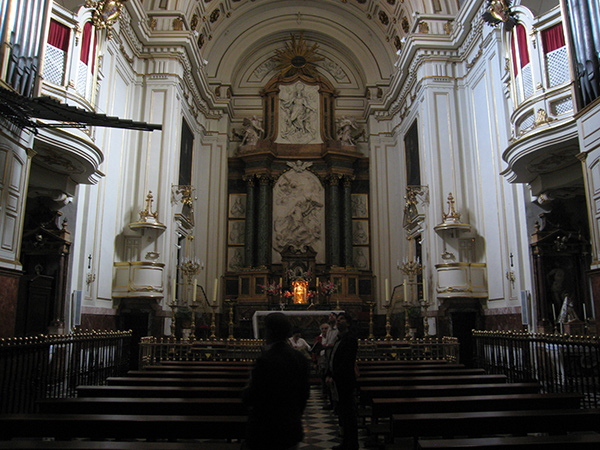
The conservation team visits the church of the Monasterio de las Descalzas Reales in Madrid. Photo courtesy Andrea Santacesaria
The panel paintings were only part of the design process for the finished tapestries, but they were also considered works of art in their own right rather early on.
That’s right; these paintings, called modelli, were an advanced stage of preparatory sketches and were probably used to present the entire project to the Infanta. They were painted on thin oak panels, in reduced scale, about seven times smaller than the tapestries. With the final designed approved, these compositions were then painted at 1:1 scale. The enlarged paintings, called cartoons, were used for reference by the craftsmen to make the tapestries.
And did Rubens make any changes during this process?
We know he changed the proportions of several compositions during the design process. One of the modelli, The Triumph of the Church, has original additions on the lateral sides, meaning Rubens enlarged the panel during the painting process. This kind of modification, not unusual on the part of the Flemish master, is an example of his constant creativity and research.
Your team, led by the Prado’s expert panel paintings conservator José de la Fuente, was dealing with extremely fragile works of art when you began treatment of the painted modelli.
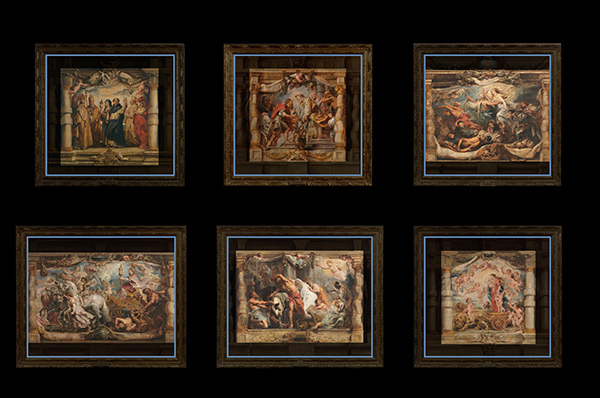
Illustration of the six modelli conserved by the team. The blue outlines correspond to the format of the modelli with the non-original enlargements. Image courtesy Jonathan Graindorge Lamour and José de la Fuente
Yes, and we believe the problems were mainly due to non-original modifications. At an undocumented date, probably at the end of the 18thcentury long after the sketches served their purpose in guiding the tapestry construction, the modelli were enlarged. The six panels that we worked on in the collection of the Prado Museum, which originally consisted of three square and three rectangular formats, were transformed into a set of four squares and two rectangles. This modification in format probably stemmed from the need to adapt the works to a new location or to new frames.
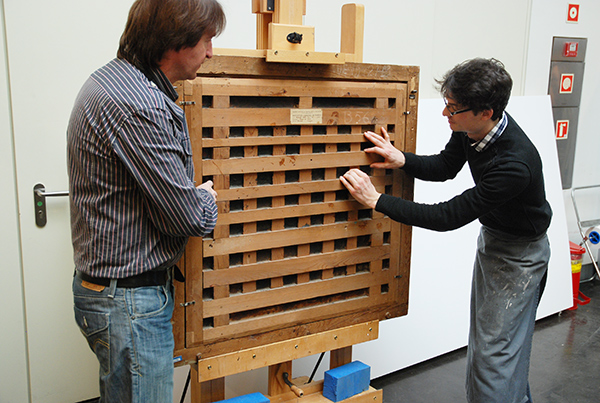
Jonathan (right) examines a cradle on the reverse of one of the Rubens panels with Prado conservator José de la Fuente (left) before removing this harmful structure.
Wood is a hygroscopic and dynamic material that changes dimensionally. The panel paintings tend to warp over time—this is the most perceptible deformation. But at the time, it was thought that the painting should remain flat like a canvas. So the modelli were thinned down with a planer to just 3-5 millimeters and forced to lie flat by being glued on the reverse to a reinforcing structure. Unfortunately these structures, referred to as cradles, restrained the natural movements of the panels to an inappropriate level. Over time, the accumulation of tensions caused stresses within the original supports. Numerous cracks and deformations appeared, followed by losses of paint from the surface.
Given these problems, how did the team proceed to correct the past interventions and stabilize the paintings?
The first step was to remove the cradles, and then afterwards we were able to separate easily the non-original enlargements to the original panels. After the removal of the cradles, we allowed the panels to settle, and they adopted a slight curvature as a consequence of the stresses induced by the stiff cradles over a long period of time.
We then moved on to address cracks and open joints that interrupted and created distortions in this general curvature of the panels. We reglued splits in order to minimize the irregularities and local distortions of the panel. After regluing, the curvature of the panels is pronounced, but still acceptable—in the sense that it doesn’t affect the legibility of the painted scenes on the surfaces.
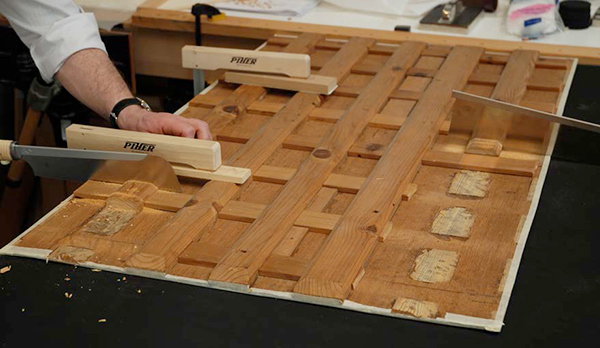
Removal of non-original enlargements to the Triumph of the Church panel
So with the old cradle systems removed, was the team’s work complete?
Not exactly. The panels still remained very fragile due to their thinness and pronounced curvature. We needed a secondary system that afforded stability but would also allow the wood to adjust (expansion, contraction, warping) to environmental fluctuations. Based on the outcomes of previous treatments that dealt with similar problems, we applied flexible perimeter strainers connected to the panels using spring mechanisms and tailored to the curvature of each panel. The compromise between the need for reinforcement and the need to allow for movement is achieved by the combination of strainer and springs. Finally, a protective backing of foam board seals the strainer, limiting the support’s exposure to dust and buffering environmental fluctuation.
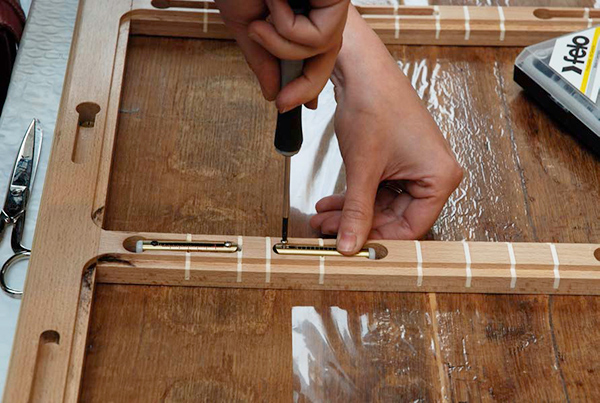
Attaching springs to the flexible perimeter strainer to stabilize one of the Rubens panels
And all of this painstaking effort is virtually invisible to visitors to the show, which I suppose means you have done your job well!
Visitors to the show can certainly appreciate the conservation of the painted surface that was carried out at the Prado following our structural work, even if they cannot see the backs of the paintings! But definitely these works would not have been strong enough to travel without our team’s structural conservation. Moreover, visitors can now appreciate the paintings in their original format as Rubens designed them.
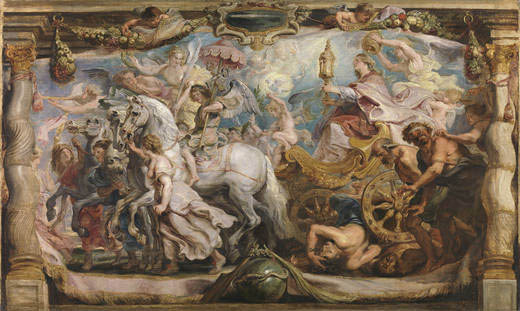
Rubens’s Triumph of the Church after treatment. © Museo del Prado
There is also long-term benefit for myself and the other mid-career conservators who participated in this training program, which means that these artworks have informed custodians for the future. Conservation requires theoretical and historical knowledge, but practical experience is also key to our work. We came together in the conservation studio of the Prado museum as conservators of different generations and skill levels: working, learning, teaching, and exchanging ideas. All of us who participated in the structural conservation now have greater understanding of the range of treatment possibilities to be in better position to propose and discuss different options for conservation.

Several members of the conservation team, from left to right: Jonathan, Sue Ann Chui (J. Paul Getty Museum), Britta New (National Gallery of Art, London), José de la Fuente (Prado Museum), and Alan Miller (Metropolitan Museum of Art)
Text of this post © J. Paul Getty Trust. All rights reserved.
Thanks to Jonathan for sharing this behind-the-scenes work. Some additional information about the Panel Paintings Initiative is included in the Getty exhibition, and a video of the conservation project is available on our website. So hurry and come for a visit before it closes on January 11!




Comments on this post are now closed.